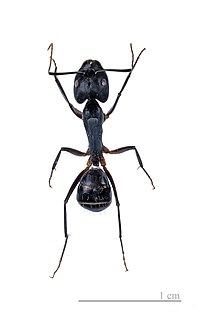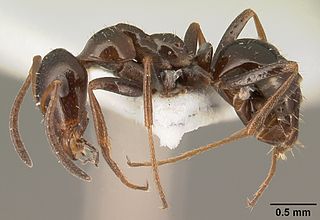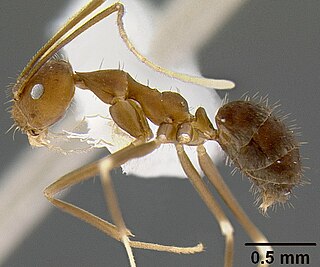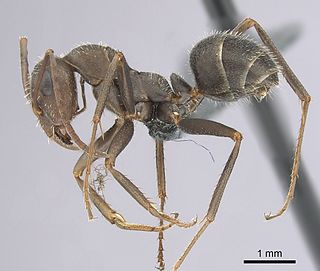
The Formicinae are a subfamily within the Formicidae containing ants of moderate evolutionary development.

Paraponera clavata is a species of ant, commonly known as the bullet ant, named for its extremely potent sting. It inhabits humid lowland rainforests from Nicaragua and the extreme east of Honduras and south to Paraguay.

Adetomyrma is a genus of ants endemic to Madagascar. Workers of this genus are blind. The type species Adetomyrma venatrix was described in 1994, with the genus being an atypical member of its tribe, the Amblyoponini. This tribe includes the Dracula ants, members of which can feed on the hemolymph of larvae and pupae.

Adetomyrma venatrix, more commonly known as the Dracula ant, so named because of its grisly feeding habits of drinking the blood of its young, is an endangered species of ants endemic to Madagascar. Workers of this species are blind. The species was described as the type species of Adetomyrma in 1994, with the genus being an atypical member of its tribe.

Cataglyphis is a genus of ant, desert ants, in the subfamily Formicinae. Its most famous species is C. bicolor, the Sahara Desert ant, which runs on hot sand to find insects that died of heat exhaustion, and can, like other several other Cataglyphis species, sustain body temperatures up to 50°C. Cataglyphis is also the name of an autonomous rover that won the NASA Sample Return Robot Centennial Challenge inspired by the navigation approaches used by desert ants.

Rossomyrmex is a genus of slave-making ant in the subfamily Formicinae. The genus consists of four species, each with a single host from the genus Proformica, and has a very wide range of distribution from China to southeastern Spain, from huge extended plains to the top of high mountains.

Tetramorium inquilinum is an ectoparasitic ant found in Europe. It was discovered by Swiss myrmecologist Heinrich Kutter. The species is unusual for lacking a worker caste, the queens and males living entirely off the care of the pavement ant. It has been called "the 'ultimate' parasitic ant" by myrmecologists Edward O. Wilson and Bert Hölldobler.

Formica sanguinea, or blood-red ant, is a species of slave-maker ant in the genus Formica characterized by the ability to secrete formic acid. It ranges from Central and Northern Europe through Russia to Japan, China, the Korean Peninsula, Africa and also the United States. This species is coloured red and black with workers up to 7 mm long.

Acropyga is a genus of small formicine ants. Some species can be indirect pests. A. acutiventris, which is found from India to Australia, tends subterranean, root-feeding mealybugs of the species Xenococcus annandalei. Living, gravid females are carried in the jaws of A. acutiventris queens during their nuptial flight, to establish the symbiotic association in founding colonies. Other Acropyga species have relationships with different species of mealybugs, and it could be a trait common to the whole genus.

Agroecomyrmecinae is a subfamily of ants containing two extant and two fossil genera. The subfamily was originally classified in 1930 by Carpenter as Agroecomyrmecini, a Myrmicinae tribe. Bolton raised the tribe to subfamily status in 2003, suggesting that Agroecomyrmecinae might be the sister taxon to Myrmicinae. It has since been discovered to be one of the earliest lineages of ants, a clade from the basal polytomy for all ants. In 2014, the subfamily was expanded to two tribes. The tribe Ankylomyrmini was moved from the subfamily Myrmicinae to Agroemyrmecinae.

Nylanderia is a large genus of ants in the subfamily Formicinae. The genus has a nearly cosmopolitan distribution with species inhabiting a wide array of habitats in almost all geographic regions. Nylanderia, currently containing over 110 species, is an ecologically important genus, with some species reported as being invasive. The ants are small to medium in size and range in color from pale yellow to black.

Proformica is a genus of ants in the subfamily Formicinae. The genus is known from the Palearctic region, from Mongolia through Central Asia to Spain. Colonies are small, generally containing a few hundred individuals, with a single queen (monogyne) or multiple ergatogyne queens. Unique in the tribe Formicini, some species have specialized workers gorged with food; they function as living storage containers.

Bajcaridris is a genus of ants in the subfamily Formicinae. Its three species are known from northern Africa. B. theryi inhabits the meadows of the Atlas Mountains in Morocco, and B. kraussii and B. menozzii inhabit the wadis of the northern Sahara in Algeria.

Alloformica is a genus of ants in the subfamily Formicinae. The genus was first described as a subgenus of Proformica by Dlussky (1969), later to be synonymized under Proformica by Brown (1973), and finally revived and raised to genus rank by Dlussky & Fedoseeva (1988). Its species are known only from a few localities.

Zatania is a genus of ants in the subfamily Formicinae. The genus is known from Central America and the Greater Antilles.

Iberoformica subrufa is a species of ant that is one of the two species in the genus Iberoformica. Described in 1859 by Roger, the species is mainly distributed to mainland Europe.

Casaleia is an extinct genus of ants in the formicid subfamily Amblyoponinae described by Pagliano & Scaramozzino in 1990 from fossils found in Europe. The genus contains four species dating from the Eocene to Miocene, Casaleia eocenica, Casaleia inversa, Casaleia longiventris, Casaleia orientalis.
















